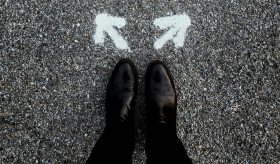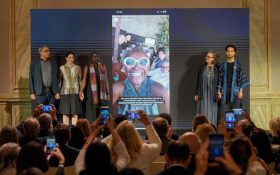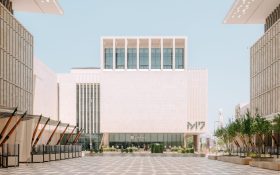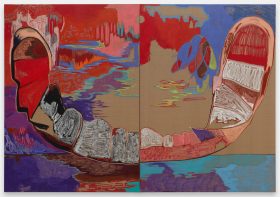Let’s begin with a truism – art appreciation is essentially subjective. What can be unintelligible to one is easily transparent to another. We evaluate art according to knowledge and experience that we as individuals own. And herein lies our problem.
Truism number two: Some will always find some art offensive. Offensive to their religious, moral, ethical or political convictions. But does that mean it is not art? Does that call for interventionism to ‘protect’ others from offense?
Moreover, the domino-nature of this argument is deeply flawed. In agreeing that art has the power to offend does not imply that explicit intent was to offend.
Let’s look at the Sistine Chapel and the now infamous Piss Christ. A juxtaposition fraught with potential offense. Yet both, in their own context, are construed to be art.
Arts Hub Global will be probing the issues that surround ‘offensive’ visual art and examining further reading material on this controversial topic. We will be looking at questions such as:
Should we accept that people have a right not to be offended by art and permit censorship? The essay Are Culture Wars Inevitable in the Arts? offers excellent insight into these issues. Is there a line that offensive art must cross before censorship is inevitable? And if censorship is something we choose to embrace, who decides what is acceptable?
Legislation for the arts is a thorny issue. We ask whether, as supporters of the arts and of freedom of expression, arts legislation is even on the agenda of senior arts strategists. Some of the policies are currently funding contemporary art that may cause offence. Are such policies sustainable, or indeed desirable?
Who are the ‘offenders’?
The following artists and exhibitions have been selected because they represent different artistic mediums as well as having the potential to cause offence to a wide range of people within the community.
Gunther von Hagens (Germany) – von Hagens’ Bodyworlds – The Anatomical Exhibition of Real Human Bodies has become an internationally recognised art brand. The official Bodyworlds exhibition is currently touring the United States and will visit Chicago, Cleveland and Ohio. Since the first exhibition opened in Japan in 1996, more than 16 million people have paid to observe human bodies preserved through a technique known as plastination. Von Hagens has developed the technique to encase bodies in polymers and preserve them indefinitely. This allows him to peel back layers of skin, expose selected muscle groups, and even dissect a pregnant woman to display the foetus.
Von Hagens justifies the exhibition as ‘health education’ targeted at a lay audience to help them develop a better understanding of the body. The two exhibitions feature over 200 bodies – individual organs, transparent vertical and horizontal slices of the body, and 25 artistically posed, whole-body plastinates.
It is the ‘artistically posed’ bodies that may be said to have caused the most offense. The dissected mother; a man arranged as if he was skateboarding; another playing basketball; and yet another carrying a jacket made of his own skin have rankled critics who claim that von Hagens exhibition is more of a freak show than a serious attempt to educate the biologically curious masses.
It would, however, seem rather premature to dismiss von Hagens’ assertion that plastination is without scientific or educational merit: according to his own press release he is currently in the process of designing the first anatomy curriculum in the United States that will use plastinated specimens in lieu of dissection.
Von Hagens does not currently describe himself or his works as an artist although he has done so in the past. It seems that now he is concentrating on developing his reputation as a scientist and educationalist. This has not stopped supporters and critics from continuing to paint him as an artist. Whilst the debate about the ethics of putting real bodies on public display was reported in the media, the real sparks only began to fly following rumours that surfaced in 2002 which suggested that some of the plastinated bodies were former Chinese prisoners who had been executed whilst others were former inmates at a Russian mental asylum.
Such rumours allegedly led to one human rights organisation expressing dismay that victims of political repression should end up as part of such a grisly exhibition, whilst a spokesman from the lobbying group Pity II (made up of parents in the UK whose deceased children’s body parts were used for medical examination without consent) said, ‘I think it is very tasteless and insensitive. That sort of thing just causes a lot of pain and prolongs suffering.’
In London, the Department of Health considered stopping the exhibition on technical grounds such was the controversy surrounding it. A ban was not enforced and the exhibition went on to prove extremely popular with the public and especially school groups who were specifically targeted by the organisers’ media campaign. With so many visitors to the exhibition it is hardly surprising that von Hagens has many supporters.
To read more about von Hagens and the Bodyworlds exhibition, find out what LA based realist painter Mark Vallen thinks, and why the controversy has spawned an array of diverse opinion in such articles as ‘Corpse exhibition faces threat of ban; Art Angles: a review of Bodyworlds; Science, art or carnival sideshow?
Science, art or carnival sideshow indeed. Whatever it can be labelled, the fascination of death is universal.
Art and politics
A marriage since the beginning of time. Art can be an expression of freedom in repression or a voice of dissent against totalitarianism of any political colour. It always has the capacity to be unsettling as it exposes political viewpoints that are not always popular. Made in Palestine the first exhibition of contemporary Palestinian art, currently touring the United States, is a case in point.
After travelling through Palestine and experiencing first hand the consequences of living in the occupied territory from a Palestinian perspective, creator Rob Eshelman returned home to the US and began trying to set up this exhibition.
The title refers to the phrase that was banned by Israeli authorities. According to Eshelman, the ‘prohibition of those words appearing on products cuts to the core of the Palestinian struggle – an Israeli occupation that attempts to thwart any assertion of a Palestinian history or identity. But the production of those goods, with their prohibited label intact, also shows the steadfastness and inexhaustibility of the Palestinian people in the face of those efforts.’
The exhibition is a collection of works from 23 artists – most of whom currently reside in Palestine – and includes two-dimensional works on paper or canvas, photos and sculpture, as well as textile and video installations.
The exhibition has just concluded its second outing in the space of two years in San Francisco after being rejected by dozens of galleries that felt the exhibits may have been too contentious for their clientele.
Eshelman describes some of the difficulties in having the exhibition mounted :
‘In November of last year, a group in nearby West Chester County, New York, organized a benefit to raise funds to have the exhibition in their community. A pair of county representatives went ballistic on hearing about the event and fired off an angry press release that characterized the Made In Palestine exhibit as ‘offensive art that glorifies terrorism’ and ‘contained anti-American, anti-Israel and anti-Jewish hatred, as well as pays tribute to terrorists.’ A state legislator described the exhibit as a ’propaganda show for assassins.’ The benefit went ahead as scheduled, but the incident exemplifies the impediments in having Made In Palestine displayed in cities across the country.’
And indeed dissent has come from far and wide from such groups as the County Legislators, who condemned the Palestinian Art fundraiser. Generally however media coverage is more curious than condemning. From Debut US tour of the “Made in Palestine” exhibition in the Electronic Intifada to issues pertaining to controversy and security measures at the exhibition. The Jewish community, however, was particularly unimpressed. Only Robert Leverant speaks out to quote Primo Levi – “The Palestinians are the Jews to the Jews.”
Art and the banal
From time to time there is public outcry about art that receives public funding that many people feel that they could do themselves ‘if they had thought of it’. Think Tracey Emin’s My Bed, for starters. The piece, shortlisted for the 1999 Turner Prize, consisted of a rumpled bed containing most of the squalor that perhaps many of us can occasionally confess to. It resold to advertising tycoon Charles Saatchi for £150,000.
Leeds UK artist Amelia Crouch’s latest work is a display of photographs which look like photographs of houses in an estate agents window on display … in an estate agents window.
The work, titled Dream House which is said to open a window on art in the street, was funded by a grant from the Yorkshire Arts Council and is part of an exhibition on display at various locations throughout the city centre. Other exhibits include flashing light-bulbs featuring the message ‘Shop or Die’ and a separate display of ‘fake’ adverts.
The artists and organisers say the works provide important social commentary but according to at least one newspaper report, local residents have found the art rather irksome. Complaints centre around the works not making any sense, not saying anything or containing any message.
The essence of what is offensive about this particular exhibition is that it doesn’t seem to be communicating anything that the audience hasn’t already thought of themselves previously. It seems to also be a complaint against the lack of skill of the artist to present material that really challenges its audience and that it is being publicly funded.
The works of Tracey Emin and Sue Williams are informed by feminism and the business of being female. Sue Williams and Karen Ireland both depict sexual brutality in very confronting ways.
In her latest public exhibition Vancouver artist Karen Ireland attempts to invoke discussion about issues of violence and repression towards women. She has been so successful in communicating these ideas that her work is to be removed from public display.
The reason given for this removal is to protect children, in the artist’s own words, “from exposure to those [violent] realities in an overt sense.” In this instance then, the artist is complicit in the removal and understands and accepts how her art might cause offence to parents and community groups and subvert the minds of children.
Taking art to the streets
The street art movement has courted controversy since it began in the form of tagging in New York in the 70s, although times have changed and so has NY graffiti . Who knew about the great graffiti wars of the late 20th century? Since then it has progressed through several stages, picking up new methods and techniques and now involving countless thousands of practitioners worldwide. The street art community is not always cohesive. We never looked like this artists cry, but one thing its members share is the ability to cause offence simply by making their art, as it is predominantly executed on property they do not own and without permission. This has led to a number of cities such as the City of Vancouver to create an anti-graffiti strategy.
The offensiveness attributed to street art has at times seen it paid serious political attention. The links below include efforts by councils to either eradicate or incorporate street art into the community.
Whilst there has never been a comprehensive survey of public attitudes toward street art, there are clearly supporters and detractors in every community. The artists themselves care little whether their art is accepted or not.
From death to birth
If the public is fascinated by Bodyworld and the mystery of death, what will they make of recent news that a couple is about to give birth in gallery in Berlin? The public response has been what might have been expected.
Religion and sex
Perhaps equally as expected, Andres Serrano’s urine-drenched work Piss Christ (1989) has evoked strong reactions wherever it has been shown. When on display in Melbourne, Australia in 1997, it was attacked on two occasions by members of the public. But the work has also created artistic responses .
Meanwhile a Greek court okays a naked surfer Jesus comic. Whilst in France, an advertisement based on Leonardo’s ‘ Last Supper was banned following protest.
The French decision to ban this advertisement was made on the basis that the religious reference caused offence. The rise in neo-conservatism and censorship is a growing trend across the west, and this might be one of many examples of censorship to come.
If it’s not religion, it’s sex. In 1999 a Nebraska court ruled that gay art was legally obscene. Why? The short answer might be because it simply was gay.
The right to offend and the right to censor
Some would argue that Piss Christ and the Andres Serrano controversy provides a useful vehicle for discussions of artistic freedom. Should the right to artistic freedom be sacrosanct, as argued by, amongst others, Germaine Greer. Or should the rights of those offended supersede any right of an artist to cause offence? The National Coalition against Censorship provide a selective time line of censorship in the USA, and one example of such debate is the Mapplethorpe Censorship Controversy,
And what of the media? Let’s not pretend that there isn’t mileage in making a work of art appear to cause widespread offence when in fact it might not, or of misrepresenting the nature of the artwork and showing it to be offensive when, again, it might not have been.
Recently a Scottish artist is alleged to have vandalised cars with a key by scratching the paintwork of random cars in the name of art. It transpires however that the artist did not in fact scratch any cars without first obtaining permission from the car owners, who were friends. Yes it was all a hoax. And in this instance, the artist was using the media, which was only too willing to go along for the ride.
Money matters
Should art deemed offensive be funded with public money? Or are restrictions to funding also serving the same purpose as censorship.
Without public funding a lot of art won’t be created, or publicly displayed. However, the separation of funding from freedom of expression is more significant when it comes to making political decisions about whether to allow publicly funded exhibitions of offensive art to go ahead. Politics as (bad) art is all about crossing this line, and the Constitutional Rights Foundation examines problems in the National Endowment for the Arts (NEA) funding battle with the US government.
The argument that an out of touch elite is responsible for doling out funding for projects that are irrelevant has a strong following.
Critics argue that funds to ‘useless’ arts should be cut. One particular critic considers the colourful proposition that one man’s dung is another man’s art.
The funding of art by federal government is protected in the US under the First Amendment as long as it is ‘useful.’ However, a definition of usefulness that is acceptable to all is about as forthcoming as a definition of art. Rudolf Giuliani suffered this dilemma. Decency, the Arts and the First Amendment is a great example of these circular arguments as we attempt to define good art and bad art, and distinguish between what is offensive and insightful
But just because it is broadly protected doesn’t mean it necessarily should be funded, although a 1999 survey found that most Americans would not support government restrictions on arts funding. In fact one particular case at the Brooklyn Museum saw enormous support for the museum’s efforts to claim their First Amendment right to display controversial art.
Even with the Supreme Court making the recommendation for NEA to evaluate grant applications with an eye on upholding decency, the process of funding the arts remains outside the objective medium of science. And the question remains is limiting funding for the arts censorship, or good sense?
The arguments surrounding offensive art are problematically circular and the will to censor or restrict funding is arbitrary according to the mindset of those who would call for such extreme action. Art is subjective, funding decisions equally so. Impasse?
While we are debating, the prevalence of ‘offensive art’ suggests that individual artists feel that they are able to exercise artistic freedom and will continue to do so in the face of calls to restrict it. At least in democracies.




